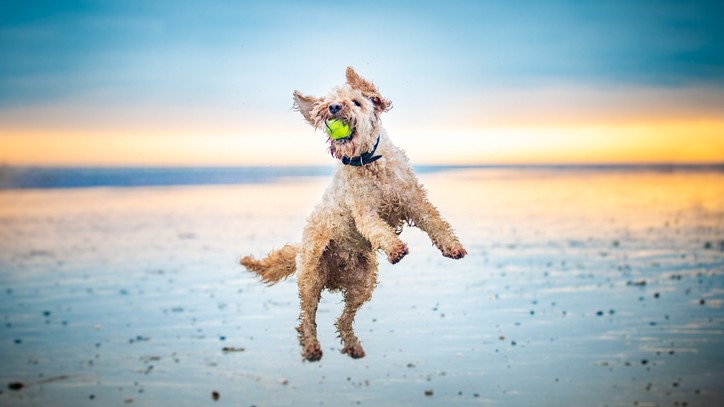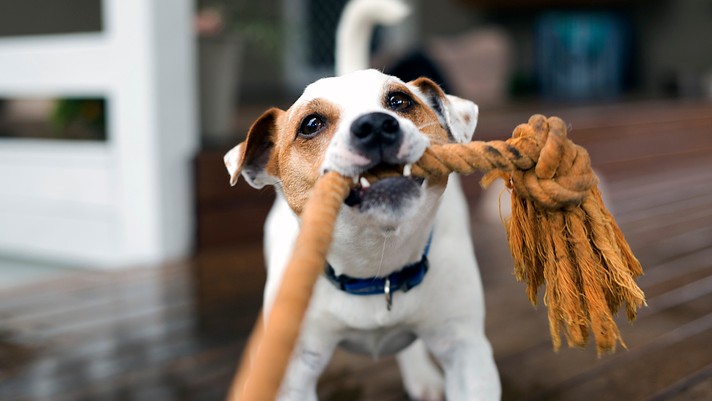A vet’s guide to dog exercise: How to keep your canine physically and mentally fit
Does your dog exercise enough? Find out how to keep your canine companion active without overdoing it

Just like us humans, our dogs need regular exercise to keep them fit, healthy, and mentally stimulated. Although your dog may love spending his days on the couch, a lack of exercise can lead to many serious health and behavior problems. Dogs that don’t receive enough daily activity are more prone to developing destructive behaviors, anxiety, and orthopedic problems. So how do you get your pup up and moving? Buying a selection of the best dog toys will help encourage activity and mental stimulation but you can also check out these tips to get started with a new exercise routine for better health.
Start exercising your dog gradually
The average human can’t jump up and run a marathon without significant training – and neither can the average dog! Your pup needs some time to build up his stamina before he starts tackling any prolonged or strenuous exercise. To avoid injury, start out with short exercise sessions and gradually increase your efforts as your dog builds strength and endurance. Try starting with a low-impact activity, such as walking or swimming, for just 10-15 minutes a day. Each week, you can add another 5-10 minutes of daily activity to your dog’s routine.
Some dogs may need to increase their activity level more gradually, so keep a close eye on your dog to see how he responds. If your dog is overweight or has health concerns, such as joint pain, they may be more prone to injury when they first start a new exercise routine, so be especially careful in these cases. A good rule of thumb is to always stop the activity before your dog seems tired, which will prevent fatigue and leave him wanting more! However, if your dog seems sore or tired after exercise, or if he’s ever reluctant to perform an activity he usually enjoys, consult your veterinarian before proceeding.
Get the right amount of exercise
The ideal amount of exercise varies from dog to dog. Factors to consider include your dog’s age, breed, current activity level, weight, and health status. For example, a senior French Bulldog with arthritis will likely need much less daily activity than a young, healthy, high-energy breed like the German Shepherd. In general, a good rule of thumb is to aim for at least an hour of activity daily, but you may need to adjust this amount depending on your dog’s individual needs.
While this may seem like a lot to keep up with, keep in mind that your dog’s daily activity does not need to happen all in one session. Shorter exercise sessions scattered throughout the day are a great way to fit more activity into your busy schedule without putting too much strain on your dog. And if you can’t get out for that long walk today, don’t worry, even a little exercise is better than none, so just try some indoor games for dogs! Your dog will still benefit from a quick game of fetch or a few laps around the yard, even if it isn’t his usual routine.

Choose the right activities for your dog
Not every dog is willing and able to perform the same types of exercise, so you’ll need to consider your dog’s individual needs when developing an exercise plan. Senior dogs and those with health issues, such as obesity, or orthopedic disease, generally do best with low-impact exercises like walking or swimming. High-energy dogs may prefer more active pursuits such as agility, flyball, or even just a tug-of-war with a rope dog toy.
To avoid injury and orthopedic problems, puppies should not participate in any forced exercise – that is, any activity beyond what they would normally participate in with other puppies of the same age – until they are fully grown and their growth plates have closed. This means that your puppy can safely enjoy a good romp in the park, but sustained activities like running with your dog should be avoided until your puppy is fully grown. Exercise doesn’t always have to be intense, either.
Simple activities like food enrichment, nose work or puzzle toys are great ways to add some extra movement to your dog’s day while also giving him plenty of extra mental stimulation too.
Safety precautions for dog exercise
Whenever you and your dog head out for some exercise, you may need to take some precautions to make sure your dog stays safe during the activity. Always be aware of weather conditions prior to outdoor activities. Most pet owners know that high temperatures and humidity can put their dogs at risk of heat stroke. However, dogs that are overweight, brachycephalic (short-nosed), or participating in strenuous exercise may experience heat stroke even at lower temperatures. Be sure to offer your dog plenty of fresh water, before, during, and after exercise and take frequent breaks for your dog to cool off.
Similarly, limit your time outdoors during particularly cold weather, especially if your dog is very young, elderly, or thin-coated as these animals may be more susceptible to the cold. Protective gear such as boots, the best dog coat, and reflective vests are also great investments to keep your dog safe year-round. Be sure to also keep your dog leashed, particularly in areas where he may become lost or injured or where he may encounter other animals. Most importantly, always supervise your dog during exercise and stop if he seems stressed, tired, or uncomfortable at any point during the activity.
Get out and get active
Even a little exercise is better than none! If your dog has previously been a couch potato, getting him started with an exercise routine – even if it’s just 10 minutes a day – can make a huge difference in his health and well-being. By starting out gradually and tailoring your exercise program to meet your dog’s needs, your pup will be able to graduate from couch potato to canine athlete in no time!
PetsRadar Newsletter
Get the best advice, tips and top tech for your beloved Pets
After graduating as a vet from the University of Nottingham, Dr Joanna Woodnutt went on to practice companion animal medicine in the Midlands. Since then, she has also written for countless online and print publications and is a regular contributor for Edition Dog Magazine.

